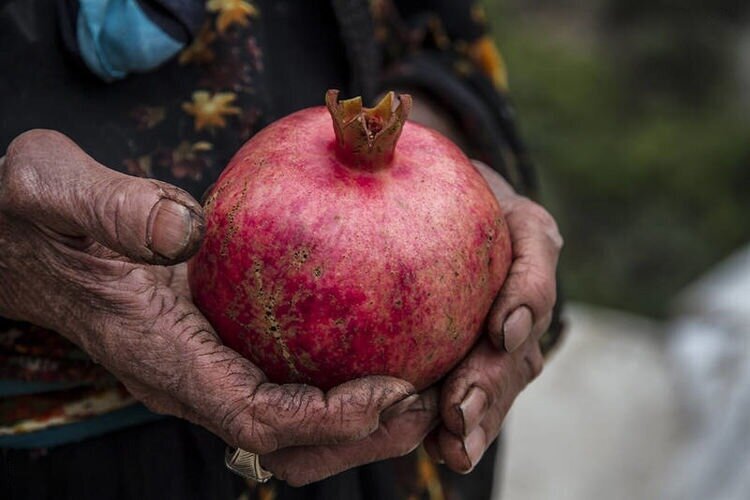Where the pomegranate blooms: Its place in Iranian life

If you visit Iran in autumn, you’ll find every greengrocer glowing with shades of red and gold! It’s a season that belongs to one fruit above all others: the pomegranate, or Anar as it’s lovingly called in Persian.
As the air cools, pomegranate harvest festivals take place across the country, especially in regions like Saveh, Yazd, Shiraz, Kashan, Qazvin, Ahvaz, and Jolfa -- all well-known for their distinctive varieties of this fruit. Actually, pomegranate is not just a fruit for the people of Iran, it’s rather a story, a symbol, and a celebration. It’s a time that honors this ruby-red treasure through fairs, local music, and joyful gatherings.
Some say, those are feasts for the eyes and soul!
For foreign visitors, strolling through a traditional bazaar during this season is a sensory delight. Vendors slice open pomegranates to reveal jewel-like seeds, while farmers proudly share tales of cultivation that go back centuries. With every stall, you feel the connection between Iran’s people, their land, and this timeless fruit that has inspired poets, painters, and cooks alike.
A symbol of fertility, abundance, and renewal
The pomegranate, in general, is deeply woven into Iranian life and identity. For generations and generations, it has symbolized fertility, abundance, and renewal, appearing at weddings, on festive tables, and in religious ceremonies. Nowhere is its importance more beautifully displayed than on Yalda Night, the ancient Persian celebration of the year’s longest night, which is now a UNESCO-listed heritage. On that lengthy night, families stay awake until dawn, reading poetry, eating watermelon, nuts, and, of course, reddish pomegranates.
Travelers visiting the country, during the occasion, will find Yalda Night a truly magical experience -- a living tradition where poetry, storytelling, and food come together beneath candlelight and laughter.
A fruit that inspired Persian poetry and art
Few fruits have touched Persian culture as deeply as the pomegranate. In the verses of legendary poets like Hafez and Sa’di, its reddish seeds become symbols of love and passion, beauty and mystery. In some cases, the act of opening a pomegranate -- revealing a thousand hidden gems -- has been compared to the discovery of truth and the unfolding of the human heart.
In art, too, the pomegranate blooms across centuries. Persian miniatures often depict the fruit in lush gardens or wedding scenes, while in ancient mosaics and modern designs alike, it stands for vitality, fertility, and joy. Travelers exploring museums and art galleries across Iran will often spot its elegant shape -- a quiet reminder of how nature and imagination meet in Persian creativity.
A flavor, you must taste!
To truly understand the pomegranate’s place in Iranian life, you must taste it. From the family kitchen to the royal table, Anar has flavored Iranian dishes for thousands of years, giving them both richness and color.
The most famous of these dishes is Fesenjan, a luxurious stew made from ground walnuts and pomegranate molasses. Simmered slowly to perfection, it delivers a harmony of tangy sweetness and nutty depth -- traditionally served with chicken or duck.
In the country, especially in cities near the Caspian Sea, visitors can try Zeytoon Parvardeh, a vibrant appetizer of olives, pomegranate seeds, walnuts, and herbs — a delicious blend of sour, sweet, and savory that captures the region’s freshness.
Beyond these classics, pomegranate finds its way into everything from rice dishes to refreshing drinks and desserts. Whether you sip its juice at a street stall or taste it in a home-cooked stew, each bite tells a story of Iranian heritage, hospitality, and heart.
Pomegranate in Iranian handicrafts
The beauty of the pomegranate extends well beyond the kitchen. Its round form and ruby-red color have inspired Iranian artisans for centuries. You’ll see its influence everywhere -- from the pottery workshops of Kashan to the carpet looms of Isfahan and the jewelry stalls of Tabriz.
In Persian ceramics, artists paint or carve delicate pomegranate motifs onto plates and vases, combining elegance with symbolic meaning. In handwoven carpets and textiles, repeating pomegranate patterns symbolize fertility and good fortune. And in traditional jewelry, artisans craft pendants shaped like the fruit -- tiny treasures that carry a touch of Iran’s cultural soul.
Visitors seeking authentic souvenirs, may find these crafts offer more than beauty; a tangible connection to the country’s artistic spirit and timeless traditions.
For travelers, following the trail of the pomegranate across Iran from harvest festivals in the countryside to pomegranate-inspired dishes in friends’ homes or restaurants, it may be an unforgettable cultural journey.
Some believe that the story of Iran’s pomegranate is, in many ways, the story of Iran itself; rich, layered, and filled with color.
AM
Leave a Comment